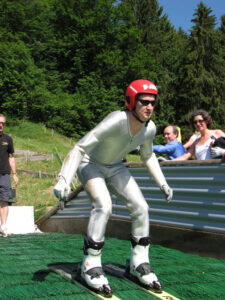Ah, summer, when a man’s thoughts turn to … ski jumping?

On Sunday I had the chance to try ski jumping, at the Swiss national team’s training center at Einsiedeln. My companions and I – or at least the ones foolish enough to try, which of course included me – donned thick neoprene bodysuits, gloves, helmets, and ski boots. We clumped up a short path then strapped on our skis and set off down the jumping track. Having skied only twice before – and that twenty-five years ago – I found this a real adventure, about which more below.
Ski jumping, it turns out, is a popular summer sport, probably more popular in the summer than the winter. I can understand why the spectators would prefer summer weather, but the jumpers’ gear felt better suited for winter than for the 25-degree Centigrade (80-degree Fahrenheit) day we had. The bodysuits are so hot, in fact, that every male jumper, whether expert or rookie, unzipped his suit and peeled it back to the waist when not jumping, exposing a tanned muscular torso, in some cases.
Skiing in summer requires a special surface. On the jumping ramp, the skis ride in two parallel tracks made of a ceramic material speckled with pea-sized bumps sticking upward so that the skis touch only the bumps. The landing area is thatched with countless thin, green plastic sticks about 20 cm (eight inches) long, anchored on one end with the other end pointing downhill. These are hosed down with water to reduce friction. At the bottom of the hill is a stopping area covered with wood chips.
After our own attempts at jumping (be patient; I’ll tell all below), we watched some expert Swiss jumpers practicing, from several vantage points. (YouTube video) From the top where the jumpers start, the ramp seems impossibly steep and stretches far below. It must take considerable courage to look down the ramp and then let oneself go. As the coach told us, once you start, there’s no turning back – you’re going to end up at the bottom of the hill one way or another. You have to be fearless. Unsurprisingly, the jumpers we saw all looked like seventeen-year-old young men.
Though the jumpers go fast, they never get very high above the ground. At the jump point, the ramp is 1.5 meters (five feet) above the ground. Below the jump point, the hillside curves down parabolically, parallel to the flight path that a jumper would follow in the absence of air resistance. So a jumper who doesn’t spring upward is never more than 1.5 meters off the ground. A skilled jumper might reach three meters (ten feet) above the ground. But then again he’ll be going very fast and will fly more than 100 meters (330 feet) down the hill.
The best view is from the takeoff point. You see the jumper start, far above. As he accelerates down the ramp toward you, his body locked in a compact crouch, you hear a ferocious clattering as his skis drum over the bumps in the ceramic tracks. Suddenly the ramp vanishes beneath him as he springs upward. At that moment he flashes past you, and the clattering is replaced all at once with an insistent whooshing, hissing sound as the jumper floats down the hill, his ski tips spread, his body leaning forward like a more aerodynamic Superman. In a second he vanishes behind the downward curve of the hill, and you wait for the faint but firm slapping noise of a safe landing. He returns to view at the base of the hill as he coasts to a stop on a flat grassy area. Nonchalantly, he removes his helmet, gloves, and skis, and half-unzips his body suit, as the next jumper begins.
The jump used by our group of rookies was maybe one-tenth the size of the big jump. Still, it looked distressingly long and steep from the top. On our first trip down the hill, we started just below the jump point, to practice skiing down the landing ramp. The trick is to maintain your balance on the strange green-stick surface as the hill curves sharply downward and then levels out again. Without ski poles, and with your ankles held rigid by the ski boots, you have little leverage to shift your weight forward or backward. Side to side balance is easy, but that’s not the problem.
As I awaited my first run, one of my companions jokingly (in German) asked the onsite medical expert how far it was to the hospital. Not to worry, she answered, the hospital was practically at the bottom of the hill. With that reassurance, I levered my skis out onto the top of the landing ramp and faced down the hill, as the coach held me motionless.
And then I was moving jerkily downhill as my skis fought the initial friction of the green sticks. I recovered my balance and picked up speed as the hill reached what seemed like a 45-degree angle. For a moment I tried to remember whether skiing on snow felt like this, but the thought was thrust aside by a rush of adrenaline and the sense that I was starting to lose my balance. As I reached the bottom of the hill any illusion of balance was gone, and I tumbled to a stop on the wood chips. I lay on my side, my skis angled awkwardly behind me, still attached to my feet. But I was unhurt and decided to try again.
On my second run, things went awry almost immediately. As I started I sensed that I was leaning ever so slightly backward. The downward curve of the hill started to tilt me backward even more. I struggled to get my center of gravity over my feet but it was hopeless. I ended up laying myself down on one hip and sliding comfortably down the last part of the hill. I was none the worse for wear, but my bodysuit was drenched from sliding over recently-watered green sticks.
I felt fine but decided not to try again. Two falls is enough for a guy of my age. I cheered on my companions as some of them managed to make short jumps and reach the bottom of the hill gracefully. Then we headed off for a delightful lunch and a tour of the Einsiedeln monastery and a stunningly restored church crowded, for some reason, with thousands of visiting Sri Lankans.
Having learned firsthand how hard ski jumping is, I was even more amazed to see the skilled jumpers casually launch themselves off the big jump. Next Winter Olympics, ski jumping will be a must-watch.
(My companions are invited to identify themselves and/or tell their own stories, in the comments.)


Leave a Reply